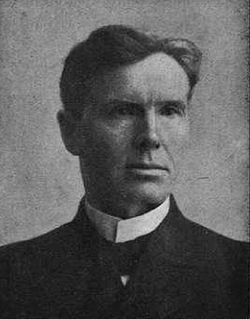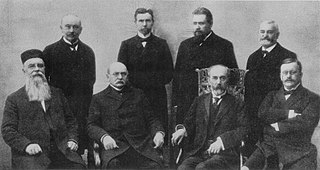
Nils Claus Ihlen was a Norwegian engineer and politician for the Liberal Party. He served as Foreign Minister of Norway from 1913 to 1920.

Gunnar Knudsen, born Aanon Gunerius Knudsen, was a Norwegian politician from the Liberal Party who had two terms as the 11th Prime Minister of Norway from 1908 to 1910 and from 1913 to 1920. He also inherited a shipping company, and founded the shipping company Borgestad ASA.

The Liberal Party is a centrist political party in Norway. It was founded in 1884 and it is the oldest political party in Norway. It is positioned in the centre on the political spectrum, and it is a liberal party which has over the time enacted reforms such as parliamentarism, freedom of religion, universal suffrage and state schooling.

The Minister of Foreign Affairs is a councilor of state and chief of the Norway's Ministry of Foreign Affairs. Since 14 October 2021, the position has been held by Anniken Huitfeldt of the Labour Party.

The dissolution of the union between the kingdoms of Norway and Sweden under the House of Bernadotte, was set in motion by a resolution of the Storting on 7 June 1905. Following some months of tension and fear of an outbreak of war between the neighbouring kingdoms – and a Norwegian plebiscite held on 13 August which overwhelmingly backed dissolution – negotiations between the two governments led to Sweden's recognition of Norway as an independent constitutional monarchy on 26 October 1905. On that date, King Oscar II renounced his claim to the Norwegian throne, effectively dissolving the United Kingdoms of Sweden and Norway, and this event was swiftly followed, on 18 November, by the accession to the Norwegian throne of Prince Carl of Denmark, taking the name of Haakon VII.

Lars Kristian Abrahamsen was a Norwegian politician for the Liberal Party. A district stipendiary magistrate by profession, he served in Gunnar Knudsen's first and second cabinets. He was Minister of Trade 1908–1910, Minister of Justice 1913–1916, and Minister of Social Affairs 1916–1919. Abrahamsen resigned on 20 February 1919.

Edvard Hagerup Bull was a Norwegian jurist and assessor of the Supreme Court of Norway. He was a member of the Norwegian Parliament and government official with the Conservative Party of Norway.

Johan Castberg was a Norwegian jurist and politician best known for representing the Radical People's Party. He was a government minister from 1908 to 1910 and 1913 to 1914, and also served seven terms in the Norwegian Parliament. The brother-in-law of Katti Anker Møller, the two were responsible for implementing the highly progressive Castberg laws, granting rights to children born out of wedlock. Altogether, he was one of the most influential politicians in the early 20th century Norway.

Thomas Thomassen Heftye was a Norwegian military officer, engineer, sports official and politician for the Liberal Party. He is best known as the Norwegian Minister of Defence from June to October 1903 and March to April 1908, as well as the director of Telegrafverket. He was killed in the Nidareid train disaster.

Anton Thorkildsen Omholt was a Norwegian civil servant and politician for the Liberal Party. He served for a time as the editor of the Dagbladet newspaper. He served as the County Governor of Nordland county from 1908 until 1913. In 1913, the Prime Minister of Norway, Gunnar Knudsen asked him to be the Norwegian Minister of Finance, a position he held from 1913 to 1920. During his time as Minister of Finance, he took two leaves of absence. One was from 23 April-16 July 1915 and the other was at the end of his term, he left on leave on 12 December 1919 and resigned from the post on 16 June 1920. He then continued with a life outside of politics.

Karl Seip was a Norwegian priest and educator, who also served as the Minister of Education and Church Affairs from 1908 to 1909.

The Government of Austria is the executive cabinet of the Republic of Austria. It is composed of the Chancellor, who is head of government, the Vice-Chancellor, and the ministers.

Stoltenberg's Second Cabinet was the Government of Norway from 17 October 2005 to 16 October 2013. It was a coalition between the Labour Party, the Socialist Left Party and the Centre Party, known as the Red–Green Coalition. On 9 September 2013, the coalition was defeated in the 2013 election.

Juho Heikki Vennola was Professor of National Economics at the University of Helsinki, a member of the Parliament of Finland, and a politician from the National Progressive Party, who served as Prime Minister of Finland twice.

Arthur Meighen was a Canadian lawyer and politician who served as the ninth prime minister of Canada from July 1920 to December 1921 and from June to September 1926. He led the Conservative Party from 1920 to 1926 and from 1941 to 1942.

Knudsen's First Cabinet governed Norway between 19 March 1908 and 2 February 1910. It had the following composition:

Wilhelm Christopher Christophersen was a Norwegian diplomat, noted for his contributions in facilitating the dissolution of the union between Norway and Sweden in 1905 and later his service as Minister of Foreign Affairs.

The Second Morrison Ministry is the 72nd ministry of the Australian Government. It is led by Prime Minister Scott Morrison. The Second Morrison Ministry succeeded the First Morrison Ministry following the 2019 Australian federal election. The ministry was announced on 26 May 2019 and was sworn in on 29 May.

The Shmyhal government is the government of Ukraine formed on 4 March 2020, and led by Denys Shmyhal.

Løvland's cabinet was the government of Norway between 23 October 1907 and 19 March 1908. The cabinet was led by Prime Minister Jørgen Løvland of the Liberal Party and consisted of nine ministers, mostly from the Liberal Party, one from the Moderate Liberal Party and two independents. During the State Council on 14 March 1908, Prime Minister Løvland asked to resign after cabinet had got a negative majority against it for the debate on the speech of the Throne. The resignation was accepted by King Haakon VII during the State Council on 18 March and took effect the day after at 10:30am. The first cabinet of Gunnar Knudsen was then appointed with immediate effect at the same time stamp.




















